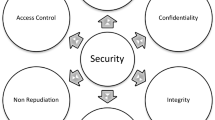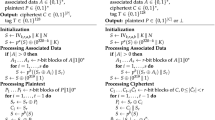Conclusion
If the model developed here for the abstract encryption/decryption channel is as general as is claimed, the discovery of asymmetric encryption techniques may be the ultimate revolution in cryptography. However, even if this should prove to be true, the impact on the practice of cryptography will continue for a very long time. For example, the mechanization of the encryption/decryption functions using computing elements, which began almost fifty years ago, has in just the past year progressed to a point where the NBS data encryption standard (DES) — a symmetric encryption scheme with a 64 bit key space [36,37] — is now offered on a single LSI chip by three manufacturers, and a two-chip MOS realization of the M.I.T. scheme with an eighty-decimal modulus has been designed. Since, in this article we were concerned more with the theory of secure communications than with the practice, no mention was made of the very significant fact that all of the asymmetric schemes which have been proposed thus far exact an extremely high price for their asymmetry — the increased amount of computation required in the encryption/decryption process cuts the channel capacity (bits per second of message information communicated) dramatically. In fact, at the moment no asymmetric scheme (to the best of the author’s knowledge) has been able to break theC 1/2 bound, whereC is the channel capacity of a symmetric channel having the same cryptosecurity and using the same basic clock or bit manipulation rate. If this difference is genuine, as we believe it to be, and not just an artifact of the asymmetric schemes which happen to have been considered, then both symmetric and asymmetric encryption/decryption schemes will be needed depending on the requirements of each application — and asymmetric techniques will not supplant symmetric techniques in general.
We said earlier that the investigation of the abstract encryption/decryption channel is the most important question in contemporary applied mathematics; others have characterized it as a multimillion dollar problem [38] awaiting solution. Irrespective of the accuracy of these judgements though, we would hope that a compelling case has been presented that contemporary cryptology is an exciting and important mathematical discipline opening challenging new problems in many areas of mathematics.
Similar content being viewed by others
References
Albert, A. A.: Some Mathematical Aspects of Cryptography. Invited paper AMS 382nd Meeting, Manhattan, Kansas, November 22, 1941
Kahn, D.:The Codebreakers. The story of secret writing. New York: MacMillan 1976
Rohrbach, H.: Mathematical and Mechanical Methods in Cryptography.Cryptologia 2, 20–37 (1978)
Sinkov, A.:Elementary Cryptanalysis — A mathematical approach. New York: Random House 1968
Friedman, W. F.:Methods for the solution of running-key ciphers. ...: Riverbank Publications No 16. 1918
Vernam, G. S.: Cipher Printing Telegraph Systems for Secret Wire and Radio Telegraphic Communications.J. Am. Inst. Electr. Engin. XLV, 109–115 (1926)
Shannon, C. E.: Communication Theory of Secrecy Systems.Bell Syst. Techn. J. XXVIII, 656–715 (1949)
Deavours, C. A.: Unicity Points in Cryptanalysis.Cryptologia 1,46–68 (1977)
Kahn, D.: Modern cryptology.Scient. Am. 215, 38–46 (1966)
Hill, L. S.: Cryptography in an Algebraic Alphabet.Am. Mathem. Monthly 36, 306–312 (1929)
Hill, L. S.: Concerning Certain Linear Transformation Apparatus of Cryptography.Am. Mathem. Monthly 38, 135–154
Feistel, H.: Cryptography and Computer Privacy.Scient. Am., 228, 15–23 (1973)
Berlekamp, E. R.:Algebraic coding theory. New York: McGraw-Hill, 1968
MacWilliams, F. J., Sloane, N. J. A.:The theory of error- correcting codes. Vols. I and II. New York: North Holland, 1977
Peterson, W. W., Weldon, E. J.:Error-correcting codes, 2nd. ed. Cambridge: MIT Press 1972
Martin, J.:Security, accuracy and privacy in computer systems. Englewood Cliffs: Prentice/Hall 1973
Barker, W. G.:Cryptoanalysis of the Hagelin cryptograph. Laguna Hills: Aegean Park Press 1977
Randell, B.: Colossus: Godfather of the Computer.New Scient. 173, 346–348 (1977)
Schatz, B. R.: Automated Analysis of Cryptograms.Cryptologia 1, 116–142 (1977)
Golomb, S. W.:Shift register sequences. San Francisco: Holden-Day 1967
Gill, A.:Linear sequential circuits: Analysis, synthesis and applications. New York: McGraw Hill 1967
Massey, J. L.: Shift Register Synthesis and BCH Decoding.IEEE Transact. Inform. Theory, IT-15, 122–127 (1969)
Purdy, G. B: A high security log-in procedure.Commun. ACM 17,442–445(1974)
Evans, A., Kantrowitz, W.: A User Authentication Scheme Not Requiring Secrecy in the Computer.Commun. ACM 17, 437–442 (1974)
Pohlig, S. C., Hellman, M. E.: An Improved Algorithm for Computing Logarithms over GF(p) and its Cryptographic Significance.IEEE Transact. Inform. Theory IT-24, 106–110 (1978)
Gardner, M.: Mathematical Games (section).Scient. Am. 237, 120–124 (1977)
Diffie, W. Hellman, M. E.: New Directions in Cryptography.IEEE Transact. Inform. Theory IT-22, 644–654 (1976)
Merkle, R. C.: Secure Communications Over Insecure Channels.Commun. ACM 21, 294–299 (1978)
Rivest, R., Shamir, A., Adleman, L.: A Method for Obtaining Digital Signatures and Public-key Cryptosystems.MIT Lab. Comp. Sci. Rep; MIT/LCS/TM-82
Rivest, R., Shamir, A., Adleman, L.: A Method for Obtaining Digital Signatures and Public-key Cryptosystems.Commun. ACM 21, 120–126 (1978)
Lipton, S. M., Matyas, S. M.: Making the Digital Signature Legal - and Safeguarded.Data Commun. 7, 41–52 (1978)
Shapley, D.: The New Unbreakable Codes - Will They Put NSA Out of Business?.The Washington Post, Sunday, July 9, 1978
Simmons, G. J., Norris, M. J.: Preliminary Comments on the M. I. T. Public-Key CryptoSystem.Cryptologial, 406–414 (1977)
Rivest, R. L.: Remarks on a Proposed Cryptanalytic Attack on the M. I. T. Public-Key Cryptosystem.Cryptologia 2, 62–65 (1978)
Gilbert, E. N., MacWilliams, F. J., Sloane, N. J. A.: Codes Which Detect Deception.Bell Syst. Techn. J. 53, 405–423 (1974)
Roberts, R. W.: Encryption Algorithm for Computer Data Encryption. (NBS).Fed. Reg. 40, 12134–12139 (1975)
Diffie, W., Hellman, M. E.: Exhaustive Cryptanalysis of the NBS Data Encryption Standard.Computer 10, 74–84 (1977)
Deavours, C. A.: The Ithaca Connection: Computer Cryptography in the Making.Cryptologia, 1, 312–317 (1977)
Author information
Authors and Affiliations
Rights and permissions
About this article
Cite this article
Simmons, G.J., Grattan-Guinness, I., Garder, A. et al. Cryptology: The Mathematics of Secure Communication. The Mathematical Intelligencer 1, 233–249 (1979). https://doi.org/10.1007/BF03028244
Issue Date:
DOI: https://doi.org/10.1007/BF03028244




